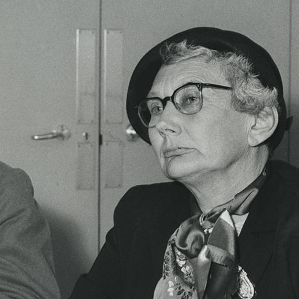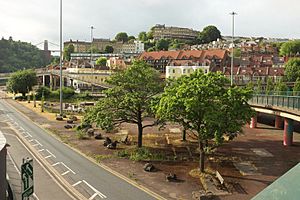Sylvia Crowe facts for kids
Dame Sylvia Crowe (born September 15, 1901 – died June 30, 1997) was a famous English landscape architect and garden designer. A landscape architect plans and designs outdoor spaces, like parks, gardens, and public areas. Sylvia Crowe was known for making beautiful and useful outdoor places. She was even given the title Dame for her important work.
Contents
Early Life and Education
Sylvia Crowe was born in Banbury, a town in Oxfordshire, England. Her father, Eyre Crowe, made furniture. When he got sick, her family moved to Felbridge, Sussex, where they became fruit farmers.
Sylvia went to Berkhamsted Girls' School for a few years. She also learned at home on the family farm because she had tuberculosis, a lung illness. Later, she studied at Swanley Horticultural College. Here, she learned all about plants and how to design gardens. Her teacher was Madeline Agar, a well-known garden designer.
Starting Her Career
After college, Sylvia Crowe worked for a company called Milner, Son & White. She spent 14 years designing gardens and landscapes. In 1939, she became a member of the Council of the Institute of Landscape Architects, which is now called the Landscape Institute. This group helps landscape architects in their work.
During World War II, Sylvia Crowe helped the Polish Army in France. After the war, she continued her important work in landscape design.
Key Projects and Contributions
From 1957 to 1959, Sylvia Crowe was the President of the Institute of Landscape Architects. She helped plan landscapes for many new towns, roads, and forests. She believed that these new developments should fit well with nature.
One of her famous projects was a special garden on the roof of the Scottish Widows building in Edinburgh. She used plants that grow naturally in Scotland for this garden.
In 1964, she designed a public square called Cumberland Piazza in Bristol. Even many years later, in 2011, the original plants she chose were still there, showing how well she planned her designs. In the 1960s, she shared an office with another important landscape architect, Brenda Colvin.
Sylvia Crowe also wrote a book called The Landscape of Power in 1958. This book gave advice on how to design large industrial areas, like power stations, so they would look better in the landscape. Her ideas influenced other designers, such as Kenneth Booth, who designed the cooling towers for the Ironbridge B power station.
In 1972, Sylvia Crowe worked with Raymond Cutbush to redesign the gardens at Lower Soughton Hall in Flintshire. These gardens still look much like she designed them, with different areas including neat hedges and mixed flower beds.
Later Life and Recognition
Sylvia Crowe received an Honorary Doctorate from Heriot-Watt University in 1977. This was a special award to recognize her great achievements.
She passed away on June 30, 1997, at the age of 95. She never married.
Awards and Honors
Sylvia Crowe received many awards for her work:
- CBE (Commander of the Order of the British Empire) in 1967
- DBE (Dame Commander of the Order of the British Empire) in 1973
- She became a Fellow of the Institute of Landscape Architects (ILA) in 1945.
- She was President of the ILA from 1957 to 1959.
- She was also involved with the International Federation of Landscape Architecture (IFLA).
- She received medals from the American Society of Landscape Architects and the Australian Institute of Landscape Architects.
- In 1990, she received the RHS Victoria Medal of Honour, a very high award for gardeners.
Books by Sylvia Crowe
Sylvia Crowe wrote many books about landscape design and planning. Some of her important books include:
- Tomorrow’s Landscape (1956)
- Garden Design (1956)
- The Landscape of Power (1958)
- The Landscape of Roads (1960)
- Forestry in the Landscape (1966)
- The Gardens of Mughul India a History and Guide (1972)



